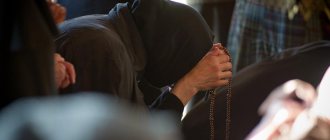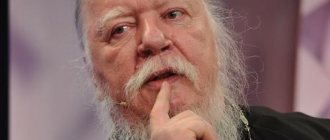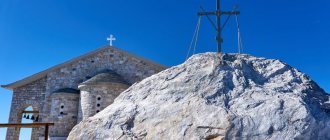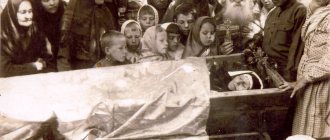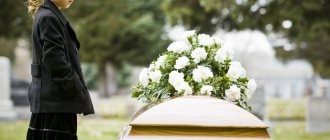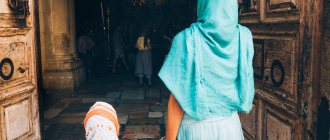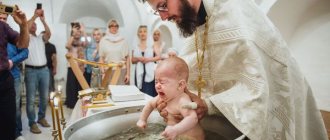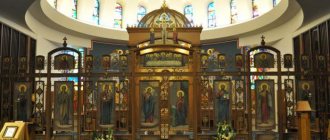Preparing the body for burial
Preparing the body for burial begins with washing, which occurs in the same order for priests and bishops. First, three clergy wipe the deceased. Movements must be cross-shaped. The body is then wrapped in cloth. After some time, the deceased is rubbed with oil. Having carried out all these procedures, the deceased priest is dressed in liturgical clothes. The person is placed in a coffin, his face is hidden under the air, the Gospel is heaped into his left palm, and a crucifix is placed in his right palm.
Features of the funeral service
“Lord, have mercy” and “The Trisagion Hymn” are sung over the body of a deceased layman, and the canon “Following the departure of the soul from the body” is also read. During the funeral service for the priest, a different canon is chosen.
The first prayer, beginning with the words “God of spirits and all flesh,” is common to all the deceased, therefore it is said both over the laity and over the deceased Orthodox priests. At the funeral of the Lord’s servants, after the first, second and third reading of the Gospel, three more prayers for repose are additionally read. In the first, the living turn to God the Father with a request to grant peace to the deceased. The second prayer is gratitude to Jesus Christ. The third is addressed to the Holy Trinity and contains a prayer to repose the soul of the deceased and give consolation to all the living.
The four Apostles (the liturgical book) and the four Gospels are also read over the body of the priest, which are interrupted by the singing of antiphons, reminiscent of the grace that the deceased will receive in the Kingdom of God. At the end, a prayer of permission is heard, and a scroll with its text is placed in the hand of the deceased.
If on the way from the church to the cemetery they sing “Holy God” over the body of a layman, then over the body of a priest they sing the irmos of the great canon “Helper and Patron.”
Who is the dead man and why are people afraid of him?
Experts believe that the anxiety caused by the deceased is a manifestation of a mental disorder. It is difficult to explain the reasons for the panic. When a phobia reminds itself of itself, it is impossible to master actions and the thought process.
There are reasons why people are afraid of the dead:
- A mixture of a depressing emotional background and negative impressions due to unpleasant memories gives rise to fear and regret.
- External changes in the body after death are frightening. The appearance of a deceased person, even if he died due to natural causes, differs from that of a living person. A haggard face and bluish skin look unnatural, and the body begins to smell of formaldehyde. If a person was killed or disfigured as a result of an accident, lay in a warm place for a long time, or was found in winter with frostbite and blackened limbs, the appearance of the deceased will be frightening. Even experienced people who deal with corpses (police officers, doctors, morgue workers) are not always able to be calm in the face of changes in the appearance of the dead.
- The dead are associated with mysticism, subtle worlds, a symbol of paranormal phenomena.
Death is a phenomenon considered unknown; fear and a desire to distance oneself from the deceased are born in the mind.
Procession and bell ringing
It is customary for the body of a lay person to be carried out to close people, but not to relatives. But the body of the priest is necessarily carried by priests in white robes. Before the coffin of the clergyman, they carry the Holy Scriptures, banners and a cross, which makes the funeral procession look like a religious procession.
Bells are rung at funerals of both laity and priests. But if, during the burial of the laity, first an enumeration of small bells sounds, and then a large bell begins, and each circle of such enumeration ends with the simultaneous ringing of all the bells, which symbolizes the end of a person’s earthly life, then the priest’s funeral is accompanied by a different bell ringing. When reading the Gospel during the funeral service, the bell is struck as many times as the Gospel has been read. When the coffin is brought into the temple, as well as after the prayer of permission and burial, a peal is sounded.
Covering the face
If a corolla with the image of Christ, the Mother of God and John the Baptist is placed on the forehead of a deceased layman, then the priest’s face is completely covered with air - a special liturgical cloth. It is applied at the end of ablution. The deceased priest is buried with him. This tradition is described in the “Great Trebnik” by Bishop Peter Mogila of the Church of Constantinople, and it dates back to the time of the burial of Jesus Christ. His body was completely wrapped in a shroud, and his face was covered with a sudar - a cloth for wiping away sweat. It is customary for monks to cover their faces as well.
This tradition is also explained by the fact that during the funeral process the soul of the deceased turns to the Lord. And nothing should distract her. Therefore, the cloth that hides the face of the deceased clergyman from those present at the funeral becomes a kind of barrier to communication with the world of the living.
